Sometimes we may meet the case that to sum numbers with the pre-condition “greater than X” exists. We only want to sum numbers which are greater than a supplied number. In this article, we will show you the method to resolve this problem by formulas with the help of Excel SUMIF and SUMIFS functions.
Through a simple instance below, we will introduce you the syntax, argument and the usage of SUMIF and SUMIFS functions. We will let you know how the formula works step by step to reach your goal clearly. After reading the article, you may have a simple understanding of SUMIF/SUMIFS functions.
Table of Contents
EXAMPLE
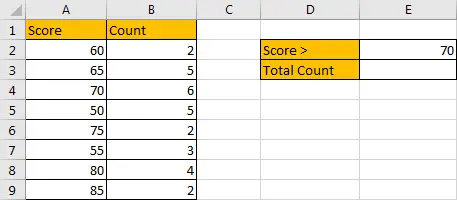
Refer to the left-hand table, we can see that there are two columns “Score” and “Count”. For each score, its adjacent cell records the number of “how many students get this score in an exam”. In the right-hand table, it is a simple summary, there is one criterion that “score is greater than 70”, and the expectation is counting the total number of students whose score is greater than 70. Actually 70 is what we just entered into E2, we can also change it to another value.
In this instance, we want to sum numbers from “Count” column based on the criteria “Score > 70 (value in E2)”. We need to find out all scores that meet our requirement, and then sum up values in “Count” column accordingly. To resolve this issue by formula, we can apply Excel SUMIF or SUMIFS functions.
FORMULA 1 – APPLY SUMIF FUNCTION
Step 1: Select A2:A9, then in Name Box define a name for this range, just use the column header ‘Score’.
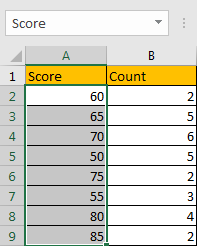
Step 2: Select B2:B9, in Name Box define a name for this range, for example ‘Count’.
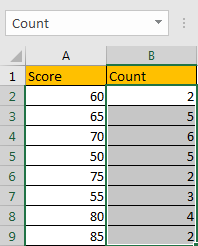
Note: Above two steps are not required, they are optional, you can directly use cell or range reference like A2:A9, B2:B9 in your formula, but for understanding well, we name ranges in advance.
Step 3: In E3, enter the formula =SUMIF(Score,”>”&E2,Count).
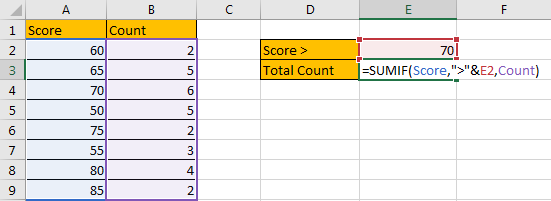
Note: In step#1 and step#2 we already name ranges “Score” and “Count”, so when entering the range information into formula, just after typing “Sc…”, our named range “Score” is loaded, just select it from dropdown list. As we explained in step#2, you can also hold and drag A2:A9 to fill the argument as well.
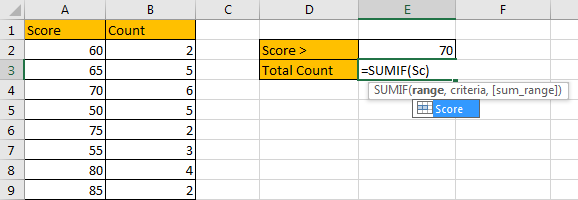
Step 4: Press Enter after typing the formula.
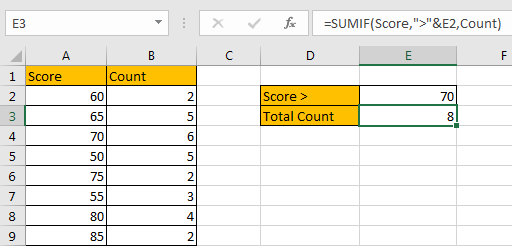
In column A, cell A6 (75), A8 (80) and A9 (85) are greater than 70, the corresponding counts are 2 (in cell B6), 4 (in cell B8), and 2 (in cell B9), so the total count is 2+4+2=8. The formula works correctly.
SUMIF FUNCTION INTRODUCTION
SUMIF function can be seen as SUM+IF, it sums numbers based on criteria. it allows user provides one pair of ‘criteria range’ and ‘criteria’.
For SUMIF function, the syntax is:
SUMIF(range, criteria, [sum_range]) – if sum range=range, then sum range can be omitted.
SUMIF function allows wildcards like asterisk ‘*’ and question mark ‘?’, it also allows logical operators within its argument. If wildcards or logical operators are required, they should be enclosed into double quotes (““).
SUMIF ARGUMENTS EXPLAINATION
SUMIF – RANGE
In this instance, we need to count numbers of student whose score is greater than 70. We need to compare each score in “Score” column with 70, so “A2:A9” is the ‘range’.
In the formula bar, select “Score”, press F9, all values in “Score” are listed in an array.

SUMIF – CRITERIA
We enter “>”&E2 into criteria part. As we mention above, if logical operator is used, it should be quote with double quotes “”; In E2 we supply a certain value “70” to filter scores; to concentrate logical operator “>” and number “70”, we must to use a special character “&” to connect them, if “&” is missing, formula quits directly.
In the formula bar, select the complete criteria, press F9.

SUMIF – SUM RANGE
In this instance, we need to count numbers of student whose score is greater than 70. So “Count” column range “B2:B9” is the ‘sum range’.
In the formula bar, select “Count”, press F9, all values in “Count” are listed in an array.

SUMIF WORKFLOW
After explaining each argument in the formula, now we will show you how the formula works with the help of these arguments.
=SUMIF({60;65;70;50;75;55;80;85},”>70″,{2;5;6;5;2;3;4;2})
We have a pair of range and criteria:
RANGE: {60;65;70;50;75;55;80;85}
CRITERIA: “>70”
Compare each number in array with 70; if number can satisfy the condition “>70”, mark it bold in array:
{60;65;70;50;75;55;80;85} – Bold if it is >70
Now, for bold numbers, as they can meet our requirement, so record a ‘True’ for them in the array; otherwise, record a ‘False’ for others.
{Flase;False;False;False;True;False;True;True}
Convert ‘True’ to ‘1’ and ‘False’ to ‘0’ to make this array can be taken into calculation in next step.
{0;0;0;0;1;0;1;1}
Now, we have below two arrays:
{2;5;6;5;2;3;4;2} – Sum Range
{0;0;0;0;1;0;1;1} – from above steps we know that if number is greater than 70, 1 is displayed in this number’s position
We list the two arrays in two rows, in the same column multiply the two numbers, and save their product in another row.

Sum up all numbers in the third row. You can use SUM function here and select all values in the third row as reference.
2+4+2=8
FORMULA 2 – APPLY SUMIFS FUNCTION
Now, let’s try to apply SUMIFS function to resolve this issue. The first two steps are the same.
Step 1: In E3, enter the formula =SUMIFS(Count,Score,”>”&E2).
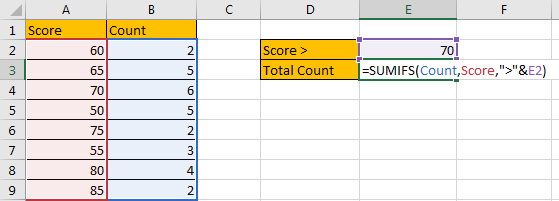
Note: We can see in SUMIFS formula, we use the same parameters compare with SUMIF, the difference is “Count” is moved to the first position.
Step 2: Press Enter after typing the formula.
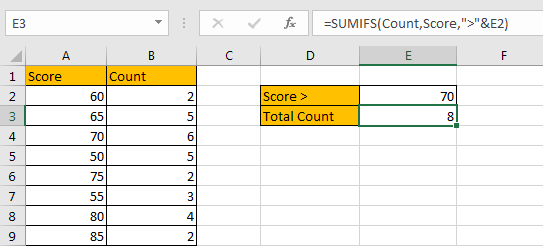
SUMIFS FUNCTION INTRODUCTION
SUMIFS function can be seen as SUM+IFS, it allows user provides multiple ‘criteria range’ and ‘criteria’ combinations.
For SUMIFS function, the syntax is:
SUMIFS(sum_range, criteria_range1, criteria1, [criteria_range2, criteria2], …).
SUMIFS function allows wildcards like asterisk ‘*’ and question mark ‘?’, it also allows logical operators within its argument. If wildcards or logical operators are required, they should be enclosed into double quotes (““).
SUMIFS ARGUMENTS EXPLAINATION
SUMIFS and SUMIF share the same parameters in this instance.
SUMIFS – SUM RANGE

SUMIFS – CRITERIA RANGE

SUMIFS – CRITERIA

SUMIFS WORKFLOW
SUMIFS and SUMIF have the same criteria range, criteria and sum range, they are processed with the same steps exactly.
SUMMARY
1. SUMIFS function can handle multiple pairs of criteria ranges and criteria. Sum range is the first argument among all arguments.
2. SUMIF function can handle one pair of criteria range and criteria. Sum range is the last argument among all arguments.
3. They allow user defined range name, wildcards, logical operators.
Sum if Greater Than A Number using VBA Code
Now, let’s explore the second method, leveraging the power of VBA coding to achieve the sum if greater than a specified number.”
Step 1: Open the Visual Basic for Applications (VBA) Editor by pressing ‘Alt + F11’.
Step 2: In the VBA Editor, click on ‘Insert’ in the menu and choose ‘Module’ to create a new module.
Step 3: Copy and paste the following VBA code into the module:
Function SumIfGreaterThan(rngCriteria As Range, criteria As Double, rngSum As Range) As Double
Dim cellCriteria As Range
Dim cellSum As Range
Dim totalSum As Double
For Each cellCriteria In rngCriteria
If cellCriteria.Value > criteria Then
' Find the corresponding cell in the sum range
Set cellSum = rngSum.Cells(cellCriteria.Row - rngCriteria.Cells(1, 1).Row + 1, 1)
' Add the value to the total sum
totalSum = totalSum + cellSum.Value
End If
Next cellCriteria
SumIfGreaterThan = totalSum
End FunctionThis VBA function, named ‘SumIfGreaterThan,’ takes three parameters – rngCriteria (criteria range), criteria (specified number), and rngSum (range to sum).
Step 4: Save and close the VBA Editor.
Step 5: Now, you can use the custom function in any cell. For example, if you want to sum values greater than a specified number in the range B2:B9 based on the criteria in A2:A9, enter the following formula:
=SumIfGreaterThan(A2:A9, E2, B2:B9)Replace A2:A9 with your criteria range, E2 with your specified number, and B2:B9 with the range you want to sum.
Step 6: Press ‘Enter,’ and the cell will display the sum based on your specified criteria.
This VBA code provides a more flexible and automated solution for summing values in Excel based on a specific condition.
Video: Sum if Greater Than A Number
This Excel video tutorial where we explore two powerful methods for summing values greater than a specified number in Excel. We’ll start with a formula-based approach using the SUMIF function and then venture into the world of VBA coding.
Related Functions
- Excel SUMIFS Function
The Excel SUMIFS function sum the numbers in the range of cells that meet a single or multiple criteria that you specify. The syntax of the SUMIFS function is as below:=SUMIFS (sum_range, criteria_range1, criteria1, [criteria_range2, criteria2], …)… - Excel SUMIF Function
The Excel SUMIF function sum the numbers in the range of cells that meet a single criteria that you specify. The syntax of the SUMIF function is as below:=SUMIF (range, criteria, [sum_range])…